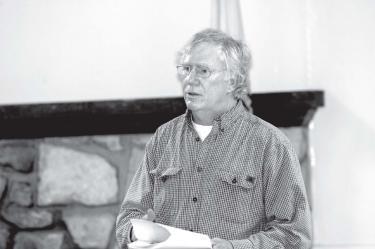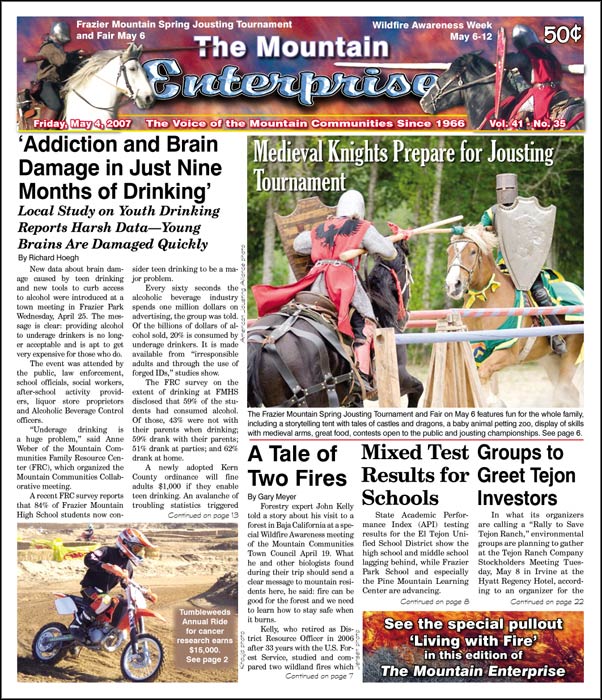
Forestry expert John Kelly tells A Tale of Two Fires during the April 19 Fire Safe Council's special Mountain Communities Town Council forum.
By Gary Meyer
Forestry expert John Kelly told a story about his visit to a forest in Baja California at a special Wildfire Awareness meeting of the Mountain Communities Town Council April 19. What he and other biologists found during their trip should send a clear message to mountain residents here, he said: fire can be good for the forest and we need to learn how to stay safe when it burns.
Kelly, who retired as District Resource Officer in 2006 after 33 years with the U.S. Forest Service, studied and compared two wildland fires which occurred in separate forests during 2003—one in the Baja California’s Sierra San Pedro Martir National Park and the other in east San Diego County.
During the Fire Safe Council’s presentation, Kelly explained his team found that the Baja forest has burned, on average, every 12 years over a period of 350 years. No fire suppression was practiced until the 1970s when only limited suppression was introduced to protect a recently built observatory.
"In this northern Baja forest, where fire had not been suppressed, there was far less buildup of fuels than in other forests where suppression is normally practiced. When fire did occur in the Baja forest, it tended not to burn into the crowns of the trees and tended to stay near the ground," Kelly said.
"These types of fires are called ground fires," he added, "whereas the hotter, more dangerous fires are called crown fires."
"The mortality rate for trees in Sierra San Pedro Martir during the 2003 fire was very low—only about 4% of the dominant trees died as a result of the fire. That forest is thriving with the regular occurrence of lower intensity fires," he said.
On his return trip from Baja, Kelly stopped to examine the forest burn areas of California’s second largest wildfire.
The October, 2003 Cedar fire, in east San Diego County, took 15 lives and burned over 280,000 acres. CNN reported at the height of the blaze that, "The entire community of Cuyamaca burned on Tuesday, according to [a] California Department of Forestry spokesman." Only the town’s fire station and City Hall were left standing.
Wildfire suppression capabilities in Southern California are among the best in the world. When lives and property are at stake, firefighters risk their own lives to protect taxpayers, often facing impossible odds against the hot, dry, high wind conditions, with little sleep.
Forestry experts such as Kelly have spent much of their careers studying fire suppression, the resultant fuel buildup and the long-range effects on the health of the forest, as At left, Forestry expert John Kelly tells A Tale of Two Fires during the April 19 Fire Safe Council’s special Mountain Communities Town Council forum. A Tale of Two Fires Continued from page 1 well as the effects on future fires.
The side-effect of having constant fire suppression over long periods of time, according to Kelly, is buildup of fuel over large areas. It is fire in these large areas of buildup that can devastate entire small communities, such as Cuyamaca. Forest managers now maintain that the more we introduce low-intensity fire under controlled conditions, the safer we’ll all be—and the healthier the forest will be—as a natural balance is allowed to return to the forest ecology.
"Fire that burns through heavy fuel buildup burns so hot that it kills the trees and endangers lives and property," Kelly said. Robert Martin, Professor of Fire Ecology at University of California Berkeley, says that a larger percentage of landscape is ultimately being burned by these large and intense fires.
The Cedar fire in San Diego County resulted in a nearly 100% mortality rate for the trees. "All of the pine trees died," said Kelly. "The Cedar fire burn area will end up being a brush field and it will be a very long time before pine trees can grow there again," he said, showing a photo of the fire’s aftermath. "When you have no seed, there is no conifer regeneration and the brush will take over the site."
Last September, the Day fire burned over 162,000 acres on our Mountain Communities’ southern border. A tiny portion of Lockwood Valley was burned in that blaze.
In December of 2005, The Mountain Enterprise went into the field with the Forest Service and ran a series of stories in January, 2006 about the Forest Service’s prescribed burn on Alamo Mountain, which is a Jeffrey pine-dominant area. According to Kelly, "The Day fire essentially went around Alamo Mountain."
Short and long-term benefits, he says, are gained from keeping fire active as part of the natural cycle in the forest. Areas treated with prescribed burns act as natural buffers to wildfire, in addition to maintaining the health of the forest itself.
In contrast, the July 2006 Scott fire completely burned the 300 year old Jeffrey pine trees on Tecuya Ridge, above Frazier Park’s north side, which had not been treated with prescribed burning.
Fire officials acknowledge that expecting fire breaks cleared with bull-dozers to protect a community is unrealistic. "The only practical course is for every homeowner to create a zone of defensible space around their home," said Kern County Fire Battalion Chief Ken Stevens at the presentation. "We will not allow our firefighters to approach a property that threatens their lives. If you create defensible space around your home, there’s a much better chance that we can send our personnel in there to defend it," Stevens said.
Although retired, John Kelly is working with the Mt. Pinos Area Fire Safe Council to lead its Chipper Day program. Kern County will bring chipping equipment to local neighborhoods and grind brush (up to 6" thick) into mulch. Property owners need only to pile the brush near the road in front of their houses. Call John Kelly at 245-1265 for information about free brush chipping in your area. Property clearances are required to be done by June 9. In some areas, the chipping equipment cannot be brought to homes, so be sure to call and ask about your area.
———————————————————-
100 Feet of Defensible Space Is The Law
In January 2005 a new state law (Govt. Code Section 51182) became effective that extended the defensible space clearance around homes and structures from 30 feet to 100 feet. Proper clearance to 100 feet dramatically increases the chance of your house surviving a wildfire. This defensible space also provides for firefighter safety when protecting homes during a wildland fire.
If your property line is less than 100 feet from your house, then the law requires you to clear only up to your property line. Do not clear beyond your property line without permission from the adjacent property owner.
In some areas of Frazier Park and Lake of the Woods, the U.S. Forest Service is working on a variance that will allow 100 foot clearance from the home onto forest lands where necessary. Contact Chuchupate Ranger Station at 245-3731 for more information.
Some insurance companies have stated that they require 100 feet or more of clearance before they will provide coverage. This has created some confusion where a property line is less than 100 feet from the home.
Contact your insurance carrier and ask whether your policy conflicts with state law.
This is part of the May 04, 2007 online edition of The Mountain Enterprise.
Have an opinion on this matter? We'd like to hear from you.


